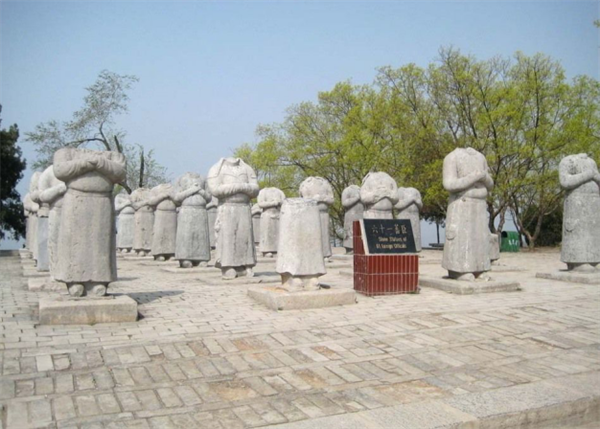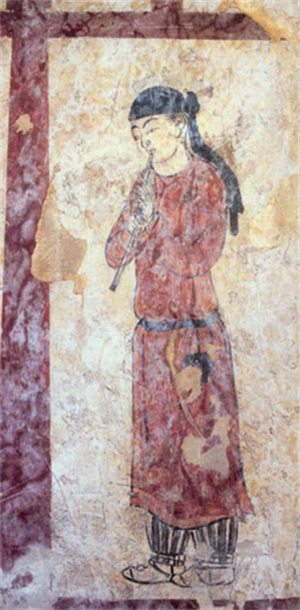Characteristics of the Tang Dynasty
The national integration in the Wei, Jin, Southern and Northern dynasties significantly broadened people’s horizons, and this situation made it possible for the Tang Dynasty to be an extensive and inclusive dynasty. In 632AD, Emperor Taizong of the Tang Dynasty feasted his senior officials. At his invitation, Illig, the former Turkic Qaghan, danced and Feng Zhidai, the Nanyue Chieftain, chanted poems. Seeing this, Emperor Taizong said, “How happy I am to see leaders from far north and south gather together!” Emperor Taizong also pointed out why he could succeed. He said, “It is because I like to see the unity of the country. I don’t like the idea that people in the heartland of China are superior to the people in other parts of China. It proves that the ruling class of the Tang Dynasty held a strong view of national unification. The awareness of “All under heaven are one family” far transcended any ideology of the rulers since the Qin and Han dynasties.

61 stone statues at the Qianling Mausoleum—They were carved under the will of Empress Wu Zetian to commemorate heads of ethnic minorities and envoys of foreign countries who attended Emperor Gaozong’s funeral, representing the ethnic unity and openness of the Tang Dynasty.
In 630AD, Emperor Taizong was titled “the Heavenly Khan” by the Uyghurs and other ethnic minorities, who also called a route from Mongolian Plateau to Chang’an as the “Access to the Heavenly Khan”. It is the only case in history to name a route with such a strong sense of ethnic unity. Therefore, for the sake of good relationship with the minorities in China, Li Shimin received the title and took it as a milestone in the course of civilization of China. Leaders of ethnic minorities lamented over Li Shimin’s death by vowing to kill themselves according to their customs. The envoy from the Tang Dynasty stopped them in time. But the leaders of those ethnic groups insisted in cutting off their ears and kneeling down to show their sadness as well as respect to Li Shimin. There were touching stories about the caring and love between the Han nationality and the minorities in China. And Chang’an City became the center of national integration at that time. In 765AD, General Guo Ziyi visited the Uyghurs alone and made a pledge with their leaders. General Guo Ziyi shouted out, “Long live the Tang Emperor! Long live the Uyghur Khan! Long live the officials of two nationalities!” It was a summary of the extensive and inclusive spirit, the first and strongest voice ever to symbolize national unity.
The broad and inclusive spirit of the Tang Dynasty attracted many ethnic minorities to live in China. For instance, Yuchi Sheng, the King of Khotan, abandoned his kingship and got an official post in the imperial court of the Tang Dynasty after helping suppress the Anshi Rebellion. Actually there were a large number of minority generals in the Tang Dynasty, and more than a hundred Turkic people had official ranks at the 5th grade and even higher than that. Not only was Turkish Qibi Heli appointed as the head of Emperor Taizong’s imperial guards, but also had the security of Chang’an been in charge by the Turks such as Ashina Sheer and Ashina Zhong for decades. Because there were so many minority senior officials, a wonder appeared in the early stage of the Tang Dynasty: At a mass meeting in the imperial palace, there were about six or seven hundred attendees. Among the officials, people in Han clothing took only one third of the attendees. The rest were minorities in the colorful ethnic clothing. Some people from the Arab Empire and Japan also held important posts in the court of the Tang Dynasty. It is worth mentioning that it took confidence for the emperor of the Tang Dynasty to give foreigners important positions in Chinese government. As the capital of the Tang Dynasty, Chang’an had about 50 thousand non-Han people (including ethnic minorities of China and foreigners) out of a population of over a million. Since ethnic minorities were very active in Chang’an, their influence far surpassed their population. For the unearthed pottery figurines, there are more figurines of the ethnic minorities than the Han People. Their life and deeds were printed in numerous literary works; and the culture and customs of the Han People at that time were even more influenced by the minorities. For instance, among the ten kinds of music of the Tang Dynasty, some were of ethnic groups such as Gaochang and Tuyuhun. It was also the same in paintings, clothing, and other fields. Yuan Zhen, a Tang Dynasty poet, described the openness which helped the people of the Tang Dynasty fully absorb diversified cultures. His poem goes like, “Exotic dresses, a languages and caravans hustle and bustle for fifty years.” Inoue Kiyoshi the Japanese scholar, pointed out in his work History of Japan that the culture of the Tang Dynasty, embodying Indian, Arabian and even Western European cultures, was worldwide. Western sinologists also expressed their high opinions about the culture of the Tang Dynast. They called Chang’an a cosmopolitan city.
The active, extensive and inclusive Tang Dynasty attracted the people from surrounding countries, especially envoys, students and monks from Silla and Japan. These people went back to Japan with the advanced culture from China so as to improve their own countries.

A Tang Dynasty tri-color glazed figurine of foreign musicians on a camel—a testimony to the prosperity of the Silk Road and the openness of the Tang Dynasty
Today you can still see the influence of the Tang culture in South Korea and Japan. People with various religious backgrounds, such as Buddhism, Islam, Manichaeism, Zoroastrianism and Nestorianism, were also attracted to Chang’an. They constructed religious buildings and conduct religious activities in the city. Buddhism was introduced into China before the Sui and Tang dynasties, whereas other religions were introduced into China for the fi rst time. It is even more commendable that the anti-traditional behaviors of women were not just tolerated, but encouraged and praised in the liberal Tang Dynasty. Delicate statues of half-naked women (hailed now as Venus in Oriental Appearance) were made in large quantities in that period of time. They demonstrate the high standard of craftsmanship as well as the openness of that time. Since it was popular for the Tang women to match appearance with each other, there were a large variety of gorgeous clothing with different styles and materials. Some were of Han-style; some from ethnic minorities; some from distant countries; some plain and simple in style for the pursuit of natural and simplicity. From the Tang figures that can be found now, the hairstyles of women were as many as 140 types. Wigs for women were very impressive in designs and materials.

Maid in men’s clothes from the Tang Dynasty tomb murals
The fast spreading and upgrading of fashion was also beyond our imagination. A new hairstyle created in Chang’an would be soon imitated by women in distant places. Neither time nor space could affect the spread of beauty. The most incredible was that it was the imperial court maids who led the fashion trend. Despite the fact that they were the group of people subject to repression and strict rules in feudal society. They designed new fashion and were free in dressing than those outside the court. They even had very low-cut dress for formal occasions. And many of them wore men’s clothes. Up to 16% of excavated figurines of women and women on murals are in men’s clothes. By being modern and fashionable, women of the Tang Dynasty also wanted to challenge men in a roundabout manner. The latest fashion trend was created by the court maids. Then the noble ladies followed the trend and spread it to the general public. The “Court Style” was the synonym of fashion at that time. Thanks to the openness of the Tang Dynasty, that is why the unique beauty of the costumes of the Tang Dynasty came into being.

A pottery figurine of a maid with a hood on horseback,a real depiction of the Tang women
In the liberal social atmosphere, it became possible for the Tang women to gain more rights and raise their social status, which was recognizable in women’s attitude towards marriage and love. They enjoyed more freedom and independence than women of other dynasties in ancient China. They loved what they loved and were not ashamed of extramarital love. Remarriage, the most likely to be condemned and prohibited behavior in feudal society, was not deemed wrong either by women or the whole society in this period. Even one as noble as the princess, they could remarry and took proud out of it. That is why moralists in later dynasties criticized Tang historians for “not respectful to the noble names”. The Song of Unending Sorrow by Bai Juyi (772~846AD, a famous poet of the Tang Dynasty), telling the love story of Emperor Xuanzong and his royal concubine Yang, was not punished for “offending” the late emperor, but rather widely spread and became a classic work about love. At that time this poem was renowned both at home and abroad. This free and open atmosphere finally found its way to politics, resulting in Wu Zetian’s enthronement. She became the only female emperor in Chinese history and was even more conceited than male rulers who regarded themselves as Tianzi (the Son of Heaven). She showed her proud by proclaiming herself Zetian (Equal with Heaven) and named herself zhao (a Chinese character she coined, meaning “the sun and moon shining in the sky”). Many of the artifacts from Wu Zetian’s time bear patterns featuring a phoenix (a symbol of noble females in traditional Chinese culture) over a dragon (a symbol of the emperor), a clear reflection of women’s rights and status in that era.


